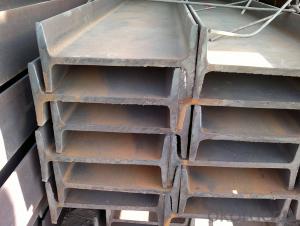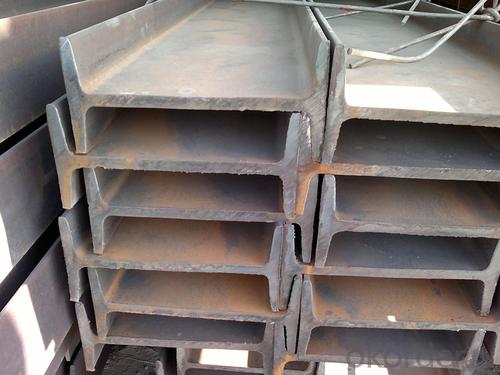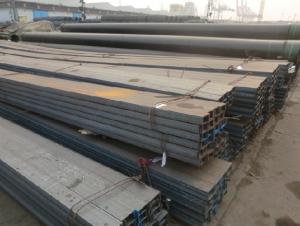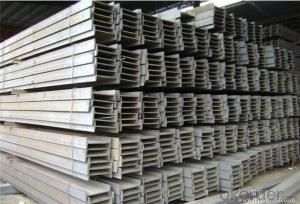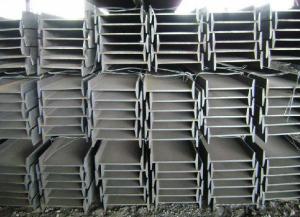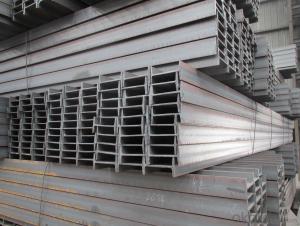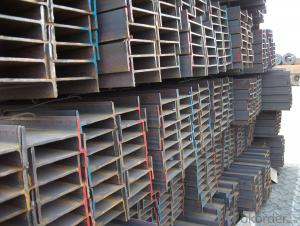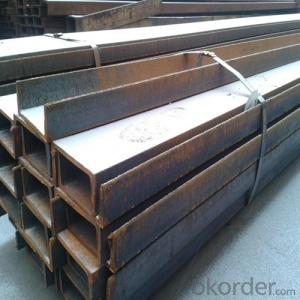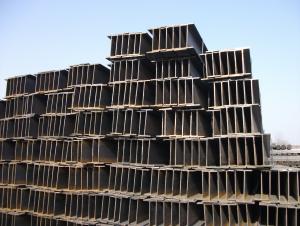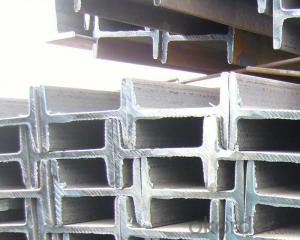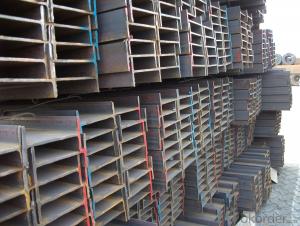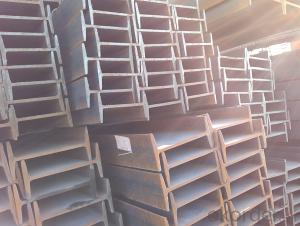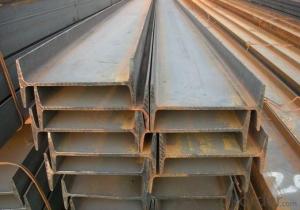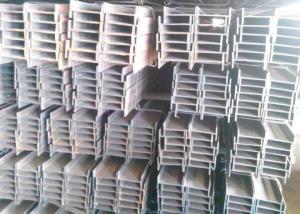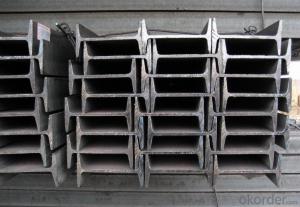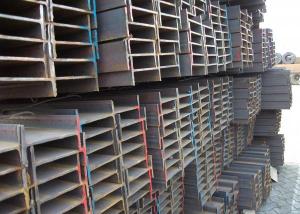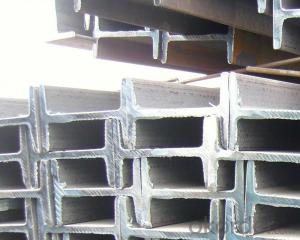I BEAMS
- Loading Port:
- China Main Port
- Payment Terms:
- TT OR LC
- Min Order Qty:
- -
- Supply Capability:
- -
OKorder Service Pledge
OKorder Financial Service
You Might Also Like
Specifications of IPE/IPEAA Beam Steel
1. Product name: IPE/IPEAA Beam Steel
2. Standard: EN10025, GB Standard, ASTM, JIS etc.
3. Grade: Q235B, A36, S235JR, Q345, SS400 or other equivalent.
4. Length: 5.8M, 6M, 9M, 10M, 12M or as your requirements
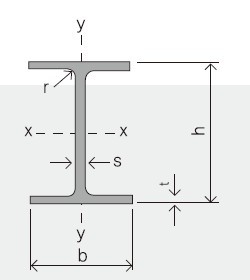
Section | Standard Sectional Dimensions(mm) | ||||
| h | b | s | t | Mass Kg/m |
IPE80 | 80 | 46 | 3.80 | 5.20 | 6.00 |
IPE100 | 100 | 55 | 4.10 | 5.70 | 8.10 |
IPE120 | 120 | 64 | 4.80 | 6.30 | 10.40 |
IPE140 | 140 | 73 | 4.70 | 6.90 | 12.90 |
IPE160 | 160 | 82 | 5.00 | 7.40 | 15.80 |
IPE180 | 180 | 91 | 5.30 | 8.00 | 18.80 |
IPE200 | 200 | 100 | 5.60 | 8.50 | 22.40 |
IPE220 | 220 | 110 | 5.90 | 9.20 | 26.20 |
IPE240 | 240 | 120 | 6.20 | 9.80 | 30.70 |
IPE270 | 270 | 135 | 6.60 | 10.20 | 36.10 |
IPEAA80 | 80 | 46 | 3.20 | 4.20 | 4.95 |
IPEAA100 | 100 | 55 | 3.60 | 4.50 | 6.72 |
IPEAA120 | 120 | 64 | 3.80 | 4.80 | 8.36 |
IPEAA140 | 140 | 73 | 3.80 | 5.20 | 10.05 |
IPEAA160 | 160 | 82 | 4.00 | 5.60 | 12.31 |
IPEAA180 | 180 | 91 | 4.30 | 6.50 | 15.40 |
IPEAA200 | 200 | 100 | 4.50 | 6.70 | 17.95 |
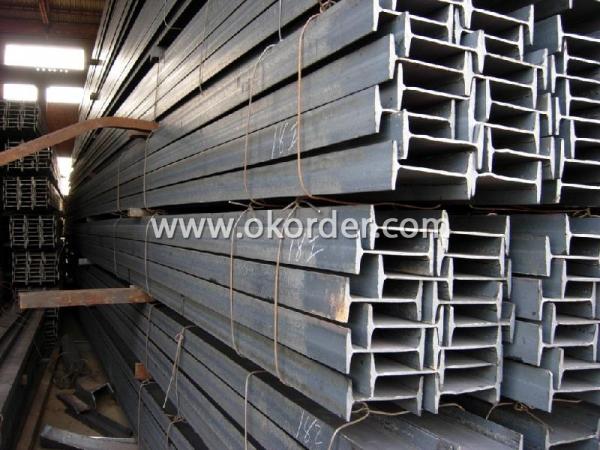
Applications of IPE/IPEAA Beam Steel
IPE/IPEAA Beam Steel are widely used in various construction structures, bridges, autos, brackets, mechanisms and so on.
Packing & Delivery Terms of IPE/IPEAA Beam Steel
1. Package: All the IPE/IPEAA Beam Steel will be tired by wire rod in bundles
2. Bundle weight: not more than 3.5MT for bulk vessel; less than 3 MT for container load
3. Marks:
Color marking: There will be color marking on both end of the bundle for the cargo delivered by bulk vessel. That makes it easily to distinguish at the destination port.
Tag mark: there will be tag mark tied up on the bundles. The information usually including supplier logo and name, product name, made in China, shipping marks and other information request by the customer.
If loading by container the marking is not needed, but we will prepare it as customer request.
4. Shipment: In containers or in bulk cargo
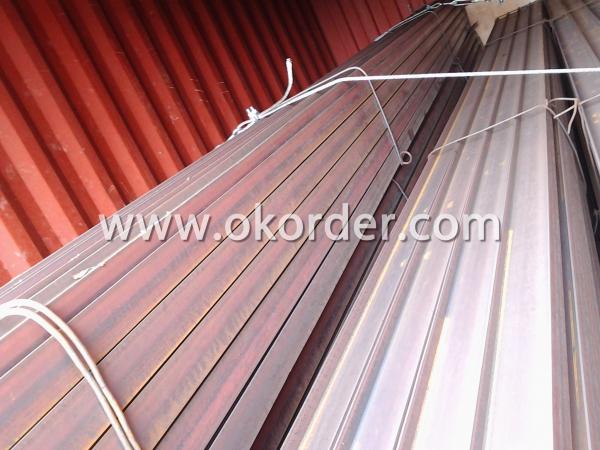
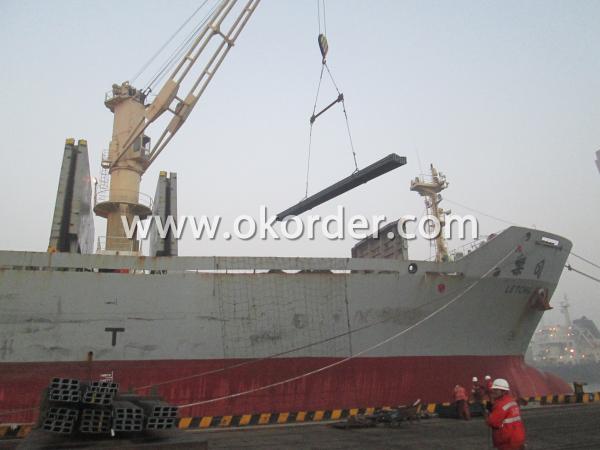
5. Delivery time: All the IPE/IPEAA Beam Steel will be at the port of the shipment within 45 days after receiving the L/C at sight ot the advance pyment.
6. Payment: L/C at sight; 30% advance payment before production, 70% before shipment by T/T, etc.
Production flow of IPE/IPEAA Beams
Material prepare (billet) —heat up—rough rolling—precision rolling—cooling—packing—storage and transportation
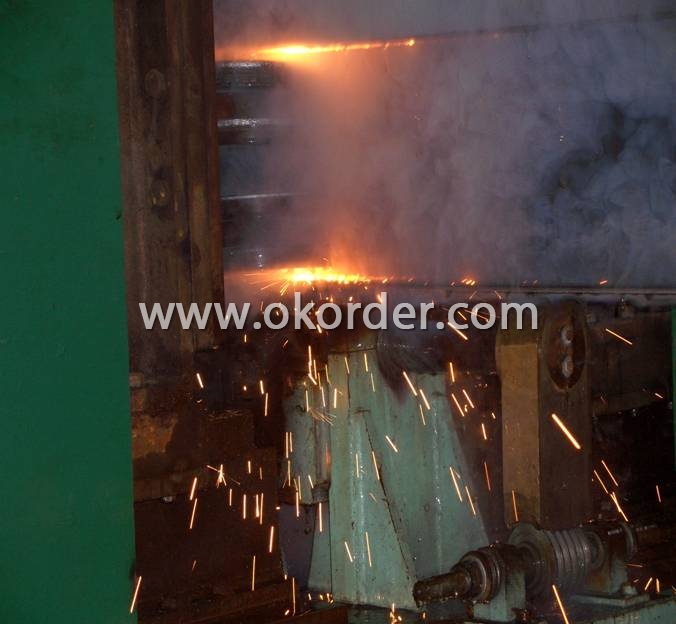
- Q: Are there any building codes or regulations that govern the use of steel I-beams in construction?
- The use of steel I-beams in construction is governed by building codes and regulations to ensure the safety and structural integrity of buildings. These codes and regulations vary depending on the country or region, but generally cover aspects such as the design, fabrication, installation, and inspection of steel I-beams. In the United States, the International Building Code (IBC) regulates the use of steel I-beams. The IBC provides guidelines for building design and construction, including the use of structural steel components like I-beams. It specifies requirements for factors such as the size, shape, connection details, and load-bearing capacities of I-beams. Compliance with the IBC ensures that the steel I-beams used in construction meet safety standards. Similarly, other countries have their own building codes and regulations specifically addressing the use of steel I-beams. In the United Kingdom, for example, the Building Regulations outline the regulations for various aspects of construction, including the use of steel beams. These regulations provide guidelines for the design, fabrication, and installation of steel I-beams. Architects, engineers, and contractors must familiarize themselves with the building codes and regulations applicable to their jurisdictions to ensure compliance with safety standards when using steel I-beams in construction. By adhering to these codes and regulations, they can ensure the safety and structural integrity of buildings and meet legal requirements for construction projects.
- Q: How do steel I-beams contribute to the overall sustainability of a construction project?
- There are several ways in which steel I-beams contribute to the overall sustainability of construction projects. To begin with, steel is an incredibly durable and long-lasting material. Steel I-beams have a lifespan of multiple decades and can endure extreme weather conditions and heavy loads without deteriorating. This longevity reduces the need for frequent replacements and repairs, ultimately reducing waste and conserving resources in the long term. In addition, steel is highly recyclable. At the end of their lifespan, steel I-beams can be easily recycled, with the recycled steel being utilized to create new products. This recycling process significantly diminishes the demand for raw materials and energy required for steel production, resulting in a lower carbon footprint. Furthermore, steel I-beams are lighter in weight compared to other construction materials like concrete. This decrease in weight load on the foundation and overall structure leads to reduced materials required and less energy consumed during construction. Moreover, the lightweight nature of steel I-beams allows for more efficient transportation, lowering fuel consumption and greenhouse gas emissions during transportation. Moreover, steel I-beams are versatile and can be prefabricated off-site. This minimizes construction waste and reduces the impact on the surrounding environment during the construction process. Prefabrication also enables faster construction, reducing the overall project timeline and minimizing disruption to the surrounding community. Lastly, steel I-beams can be designed and engineered to optimize energy efficiency. They can be integrated with insulation materials, thermal breaks, and other energy-saving features to enhance the overall energy performance of a building. This results in reduced energy consumption for heating and cooling, ultimately leading to lower operational costs and a smaller environmental footprint. In conclusion, steel I-beams contribute to the overall sustainability of construction projects through their durability, recyclability, lightweight nature, versatility, and potential for energy efficiency. They promote responsible resource utilization, waste reduction, and energy conservation, making them an environmentally-friendly choice for construction.
- Q: How do steel I-beams perform in terms of snow load resistance?
- Steel I-beams have gained widespread recognition due to their exceptional ability to resist snow loads. By utilizing a structural design specifically tailored to their purpose, steel I-beams efficiently distribute the weight of snow loads, providing optimal support and stability. The distinctive shape of the I-beam, characterized by its wide flanges and narrow web, endows it with a superior strength-to-weight ratio, rendering it highly efficient in handling heavy loads. Moreover, steel, being a robust and resilient material, possesses the capability to withstand the pressure and weight of accumulated snow without experiencing significant deformation or failure. Consequently, steel I-beams emerge as a reliable choice for structures situated in regions with heavy snowfall, as they effectively bear the weight and maintain the structural integrity, thereby ensuring the safety and stability of the building.
- Q: Can steel I-beams be used for architectural designs?
- Yes, steel I-beams can be used for architectural designs. Steel I-beams are commonly used in architecture due to their strength, durability, and versatility. They can support heavy loads, making them suitable for constructing large and complex structures such as bridges, high-rise buildings, and stadiums. The ability of steel I-beams to span long distances without the need for additional support columns allows for open and flexible floor plans, making them ideal for modern architectural designs. Additionally, steel I-beams can be fabricated to various sizes and shapes, providing architects with the freedom to create unique and innovative designs. The use of steel I-beams in architectural designs also offers advantages in terms of cost-effectiveness, sustainability, and fire resistance. Overall, steel I-beams are a popular choice in architectural designs due to their strength, versatility, and aesthetic appeal.
- Q: Can steel I-beams be used in cultural or historical buildings?
- Yes, steel I-beams can be used in cultural or historical buildings. While traditional construction materials like wood or stone are often associated with cultural or historical buildings, steel I-beams offer several advantages such as strength, durability, and versatility. Incorporating steel I-beams into the design of cultural or historical buildings can provide structural support, allow for larger open spaces, and enhance the overall architectural aesthetic. However, careful consideration should be given to ensure that the use of steel I-beams does not compromise the historical or cultural significance of the building.
- Q: How do engineers determine the appropriate size of Steel I-Beams for a project?
- Engineers determine the appropriate size of Steel I-Beams for a project by considering factors such as the load requirements, span length, and structural analysis. They calculate the maximum bending moment and shear forces that the beam will experience, and then use these values to select a beam size that can safely support the load and distribute the forces without failure.
- Q: How do you calculate the required number of steel I-beams for a project?
- To calculate the required number of steel I-beams for a project, you need to determine the total weight or load that the I-beams will need to support. From there, you can consult engineering tables or consult with a structural engineer to determine the appropriate beam size and spacing needed to safely support the load. Once you have the required beam size and spacing, you can then calculate the number of I-beams needed by dividing the total length of the project by the spacing between the beams.
- Q: How do steel I-beams perform in terms of thermal bridging?
- Steel I-beams are known to have high thermal conductivity, which means they can conduct heat more easily compared to other building materials. This characteristic makes them prone to thermal bridging, which is the transfer of heat across a building envelope or thermal barrier. When steel I-beams are used in construction, they can create a thermal bridge in the building envelope. This means that heat can be easily transferred from the inside to the outside or vice versa through the steel beams. Thermal bridging can result in energy loss and reduced energy efficiency in a building. To mitigate thermal bridging in steel I-beams, insulation materials can be added around the beams to minimize heat transfer. Insulation can help reduce the impact of thermal bridging and improve the overall thermal performance of the building. Additionally, thermal breaks can be installed between the steel beams and the surrounding building elements to further reduce the heat transfer. In summary, steel I-beams have a high potential for thermal bridging due to their high thermal conductivity. However, with proper insulation and the use of thermal breaks, the negative effects of thermal bridging can be minimized, resulting in improved energy efficiency and thermal performance of the building.
- Q: Can steel I-beams be used in the construction of high-rise buildings?
- Yes, steel I-beams can be used in the construction of high-rise buildings. Steel I-beams offer excellent structural integrity and load-bearing capacity, making them a popular choice for constructing tall buildings. The I-beam's design allows for efficient distribution of weight and provides the necessary strength to support the multiple floors and heavy loads typically found in high-rise structures. Additionally, steel I-beams offer flexibility in design and can be easily fabricated and installed, making them a preferred choice for architects and engineers in constructing high-rise buildings.
- Q: Can steel I-beams be used in sports arenas or stadiums?
- Yes, steel I-beams can be used in sports arenas or stadiums. In fact, they are commonly used in the construction of these large structures due to their strength, durability, and versatility. Steel I-beams provide excellent load-bearing capabilities, allowing them to support heavy loads and withstand the forces generated during sporting events, such as vibrations, impacts, and dynamic loads. The use of steel I-beams in sports arenas and stadiums ensures the structural integrity of the facility, providing a safe environment for spectators and athletes. Additionally, the versatility of steel I-beams allows for flexible design options and efficient construction, making them a popular choice in the industry.
Send your message to us
I BEAMS
- Loading Port:
- China Main Port
- Payment Terms:
- TT OR LC
- Min Order Qty:
- -
- Supply Capability:
- -
OKorder Service Pledge
OKorder Financial Service
Similar products
Hot products
Hot Searches
Related keywords
